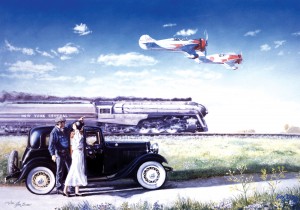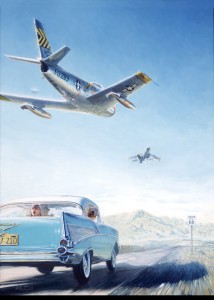By Deb Smith
When 10-year-old Alex Durr won a fifth-grade art contest, his reward was the opportunity to draw whatever he wanted. He drew an airplane—-a Japanese Zero.
While it would be many years before he would be able to understand the significance of that moment, Durr just knew that he was pleased with his work.
Born and reared in sunny Miami, Durr always had an interest in aviation, but admits it’s more a love for the machine than of flying itself, despite the fact he’s both an accomplished Marine aviator and commercial pilot.
“My mom always said that every time an airplane would fly over, I would sit and stare and watch,” said Durr from his home in Fort Worth, Texas. “But I don’t know if there really was any defining moment that made me think it was my destiny to become a pilot.”
On the other hand, Durr wasn’t opposed to the idea. “I knew I wanted to go into the military after school and the flying part seemed pretty neat,” he explained. “Before I really got serious about it, I took a one-hour lesson at a nearby airport and was satisfied that flying was something I could live with.”
Durr graduated with a fine arts degree in studio art from Florida State University and promptly entered the Marine Corps. There, he trained as a fighter pilot, flying the F-4 Phantom and the F-18 Hornet. Although he was now airborne, he still felt something was missing.
“I’ve always kind of been like a closet aviation artist,” confessed Durr. “It wasn’t until I was going though flight school back in 1984 down in Pensacola and visited the National Museum of Naval Aviation that I saw there really was such a thing as a bona fide aviation artist.”
There, Durr mused at the paintings he saw, strolling through the works of such greats as Robert Grant Smith, regarded by many as the American master. Although he was already well schooled in the subject, Durr said that was the moment he felt his “true” interest in art finally clicked.
“If it wasn’t for my lazy high school art teacher, I think I would have found this out a lot earlier,” he said. “I didn’t find out about what was going on in fine art until I was in college-—and through magazines like Art in America. We also had some traveling shows that came though, but I really had no clue as to what was going on. Had I been properly exposed to more of that in high school, I think I probably would have just gone straight to New York City after graduation.”
But things happen for a reason. As Durr began to explore the new possibilities for his craft, his military career carried him around the globe, including a tour in the Pacific. Durr eventually landed at Andrews Air Force Base, just outside of Washington, D.C., in 1992.
After his tour of duty there was complete, he left the military and was hired by American Airlines as a commercial pilot. He currently works for them as a Super 80 copilot, based in Dallas.

A couple beside a 1932 Ford Victoria watches as two Gee Bees en route to the National Air Races, held during the 1930s in Cleveland, Ohio, fly along the NYC Twentieth Century Limited.
When he’s not flying, Durr, who is married and has two children, heads up Alex Durr Productions, a fine art showcase for his work that he founded in 1992.
“I now have eight limited editions prints for sale,” he noted. “I also paint nose art. Well, I call it ‘nose art,’ but it’s really a panel made out of aluminum with rivets. Guys will send me pictures of their wives or girlfriends and I’ll put them in a pinup girl pose, as if it were on the nose of a vintage airplane.”
Durr said the best part about the job is not painting the beautiful women; it’s actually getting calls from the customer when they receive the piece.
“When they tell me how happy they are, it just really brightens my day,” he said.
Durr prefers to work in oil. “I really prefer the prestige of oils,” he explained. “I just really like the richness of the pigment and the fact it lasts so long. It’s my favorite.”
While many artists are inspired by the works of masters such as Rembrandt and Monet, Durr said he is most inspired by Leonardo da Vinci.
“I know it probably sounds a little weird, but I always thought da Vinci was cool, because he not only painted, but was into engineering and science as well,” he said.
Perhaps da Vinci wasn’t completely off, as Durr said the realism in his work can be quite challenging—-considering his audience.
“When you work with realism, you have to hit everything just right,” explained Durr. “You have to follow the laws of physics, perspective, the way the light shines, the way it reflects, and colors and things, especially with painting airplanes. It’s almost like painting a portrait; pilots will automatically know if something is out of whack.”

While in the Marine Corps, Alex Durr trained as a fighter pilot, flying the F-4 Phantom and the F-18 Hornet.
Durr’s work has earned him several national honors, including two first-place wins in EAA’s Aviation Art contest, held each year at Oshkosh.
One of those prize-winning works, entitled “Cruisin’ on Route 66,” features a flight of F-86 Sabres buzzing a classic 1957 Chevy Belair, as it speeds down a desolate stretch of America’s best-known roadway. A young girl in the back seat of the car stares out of the back window in awe.
“The little girl in the back of the car is my daughter,” chuckled Durr. “That scene never really happened. I was lucky enough to be able to visualize the scene before painting it. I used models and then had my daughter pose on a chair as if she were looking up and seeing the planes.”
“To the Races,” Durr’s first in a series of “planes, trains and automobiles,” is his most popular print so far. Printed in 1994, the original hung in ASAA’s 1994 Juried Show. It features two 1930 Gee Bees, a 1938 NYC 20th Century Limited Streamlined Hudson, and a 32 Ford Victoria. His uncle and wife Agnes posed for the painting.
If he had to choose, Durr said he would take painting over flying.
“I guess, for me, the passion part of aviation comes in my painting,” he confessed. “The flying part is really kind of like a job…but the view up front is terrific…the scenes with the clouds, skyscrapers and everything.”
Durr is a member of the Society of Aviation Artists and the Air Force Art Program. He also has two paintings on display with the Air Force, as well as work at this year’s CAE SimuFlite annual Horizons of Flight Aviation Art Exhibition and Competition.
Alex Durr is currently accepting commissions. Interested parties may request a brochure online at [http://www.alexdurr.net/] or call 800-397-6529.












